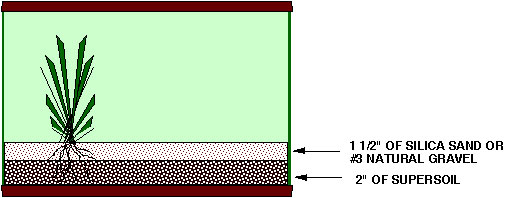Potting Soil
Potting Soil Aquatic Plant Growing Technique

By Tony Griffitts
Published - 1997, Revised:
This concept (1997) is new to keeping aquarium or pond plants. I first heard about this technique from Earl Jack, a Sacramento Aquarium Society (SAS) member, who is a master at growing aquatic plants. He uses this technique to grow some of the best aquatic plants I have ever seen. Earl presented at a SAS meeting on May 3rd,1997, and showed us his plant growth technique.
Earl does not use laterite or plant fertilizers. He uses potting soil and chelated iron (used for growing marine macroalgae). Earl also does not use the expensive fluorescent bulbs you buy at the aquarium store, he uses the cheaper bulbs you buy at the hardware store. Today (2023), you can use full spectrum LED lights, flood lights, spotlights, and stoplights. Earl does not use carbon dioxide (CO2,) either.

Here is the basic technique Earl uses for growing his plants: Before you add water to the aquarium, you need to prepare the gravel bed for planting the plants. Use potting soil for the bottom 2-inch layer of the bed and top it off with 1 1/2 to 2 inches of #3 (mesh or grit) natural gravel or silica sand.
Make sure you thoroughly clean the sand or the gravel before you top off the potting soil. The gravel or sand will help keep the potting soil from floating to the top of the water. The potting soil can be purchased at most garden supply stores and is relatively inexpensive. After adding the potting soil bed, add water slowly by pouring it on a plate. You do not want to disturb the soil, otherwise, you will have a lot of soil floating at the top of the water, and that can make quite a mess.
After the aquarium has been filled with water, you can then start planting the plants. Add chelated Iron to the water as recommended for marine macroalgae. Another technique that Earl uses is adding the potting soil to a plastic container and placing it in an aquarium.

Earl highly recommends using the Melanoides tuberculata (Malaysian trumpet snail [MTS] or Malaysian livebearing snail) that likes to burrow in the sand and the gravel. MTS brings fresh water to the roots of the plants and helps control some types of algae.
The technique outlined in this article for keeping aquatic plants was later popularized by Diana Walstad in her book Ecology of the Planted Aquarium: A Practical Manual and Scientific Treatise and is commonly referred to as the Walstad method in the aquarium hobby.